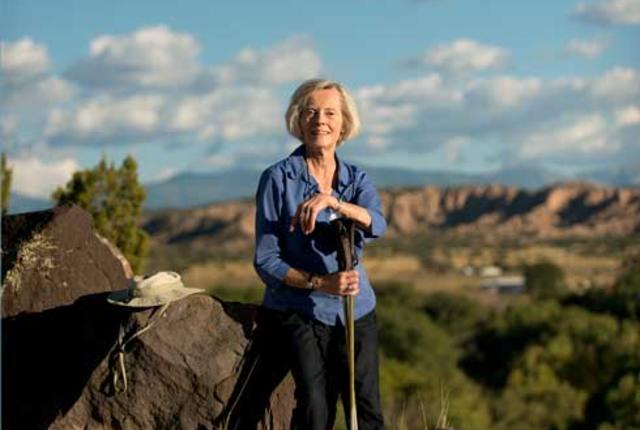Above: Katherine Wells atop rock-art-rich Mesa Prieta.
AS SHE RODE WITH her real estate agent past black boulders and juniper trees, Katherine Wells was so weary of searching for a new place to call home that she was ready to return to California and forget about northern New Mexico. Wells, then 55, stepped outside on that warm March day in 1992 and looked up a rocky hill. What she saw erased her fatigue and transformed her future. She raced uphill through cactus to a mammoth stone, and there they were—lightning-shaped snakes, a four-pointed star, a crescent moon, a cloud terrace, and a mysterious bird, all pecked into the surface of the rock. She instantly knew she was meant to live there. It wasn’t until later that she understood why.
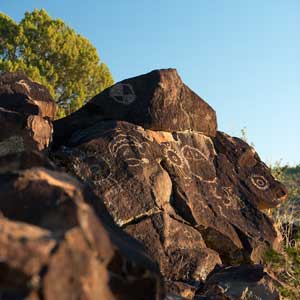 Glyphs at the Wells Preserve.
Glyphs at the Wells Preserve.
Wells was born at the end of the Great Depression in Kansas City, Missouri, the youngest of four children. Inner drive pushed her beyond her father’s expectation that she marry and her mother’s plan for her to work as a secretary. Her dream was to be an artist, and she graduated from college qualified to teach. She married, raised a son, taught high school, and divorced, weaving art into her life as a collector of Native American basketry and as an entrepreneur of a silk-screen business. The first time she saw an image of a turtle carved into the walls of a cave in Utah, she was enchanted, and not just by the aesthetic quality of the glyph: She felt a mystical connection with the past and the person who carefully etched the image so long ago.
It was midsummer when Wells and her partner, Lloyd Dennis, returned to build her art studio and their straw-bale house on the flat portion of their 188-acre property. In those busy, early days on Mesa Prieta, she explored in the early-morning hours, before the sun was too intense. She sat beside cherished images, absorbing the view of the Sangre de Cristo Mountains, stretched across the eastern horizon, and the shimmering Río Grande below. One male figure holding a shield soothed her during a stressful time of establishing water and electricity on the isolated, off-grid property, about an hour north of Santa Fe. As weeks turned into months, she slowly realized that the quantity—thousands upon thousands—and quality of these images on her land were significant to New Mexico’s cultural and historical legacy.
“I couldn’t believe what I was seeing,” she says 24 years later. “I had been to a number of sites, and this was as good as, if not better than, anything I had seen before. And I was living here and in charge of it.”
Although Mesa Prieta wasn’t well-known to the public at the time, Wells gathered information about the area and glyphs by quizzing local archaeologists and doing her own research, which confirmed 10,000 years of human activity there. She learned that Mesa Prieta, meaning “dark mesa,” contained images dating to three periods of New Mexico history: Archaic, Puebloan, and Historic.
From the Archaic period (8000–500 BC), Wells found abstract images, including repetitive designs of parallel lines, circles, rakes, zigzags, and one-pole ladders. The nearby Río Grande provided an essential resource as people made the transition from solely hunting and gathering to cultivating plants and building housing structures.
Most of the images Wells discovered are dated between AD 1300 and 1600, during the Pueblo IV era, when ancestors of present-day Tewa people favored depictions of dancers, hunters, warriors, animals, and flute players. The Puebloans were prolific in pottery, making vessels for storage, cooking, trading, and ceremonies.
The Historic period began with the arrival of the Spanish. In 1598, Juan de Oñate established the first Spanish capital of New Mexico a few miles south of Mesa Prieta at Ohkay Owingeh Pueblo (formerly San Juan Pueblo). From this period, Wells found such images as Christian crosses, horses, horseback riders, churches, and lions. She noticed it was common to see Historic and Puebloan glyphs next to one another. This overlay of Spanish and Native American imagery is unique to northern New Mexico.
The more Wells learned, the more she realized she couldn’t focus solely on making mixed-media art, as she’d planned to do when she moved here. A different path revealed itself to her: The petroglyphs needed her protection, and the world needed to know about them.
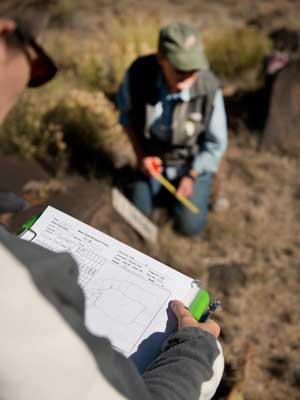 The Mesa Prieta Petroglyph Project is trying to record every glyph on the 12-mile-long mesa.
The Mesa Prieta Petroglyph Project is trying to record every glyph on the 12-mile-long mesa.
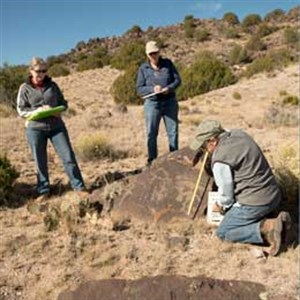 Volunteers measure a previously
Volunteers measure a previously
undocumented image.
Estimates of how many petroglyphs are on the 12-mile-long mesa of basalt formations keep rising. Trained volunteers have surveyed less than half of the formation, recording 50,000 glyphs, and today’s estimate is up to 75,000 for the whole mesa. In this petroglyph-rich state, Mesa Prieta stands out for its sheer volume and unique features, including European heraldic lions that area archaeologists haven’t seen anywhere else in the world. It is the biggest petroglyph site in New Mexico, with more glyphs than the Petroglyph National Monument in Albuquerque and Three Rivers Petroglyph Site near Alamogordo combined.
To protect the petroglyphs, Wells donated 156 acres of her land, now called the Wells Preserve, to the Archaeological Conservancy, which also bought another 25 acres. Eighty percent of Mesa Prieta is privately owned, and about 20 landowners have given Wells permission to record the glyphs on their property. The U.S. Bureau of Land Management owns most of the remaining 20 percent, with a small portion belonging to Ohkay Owingeh Pueblo. Wells established the Mesa Prieta Petroglyph Project in 1999 with a network of 100 volunteers dedicated to preserving the glyphs and educating local schoolkids and the public. Today the project hosts docent-led tours, usually in the spring and fall.
I joined a special tour held in conjunction with Santa Fe’s annual Spanish Market last July. Esta Gutierrez, Mesa Prieta’s education coordinator, gave the six of us a brief geology lesson before we explored. She explained that the large basalt boulders were formed from volcanic rock that originated a little more than three million years ago from a fissure eruption to the north. The black surface of the rock is a result of weathering and chemical changes over centuries.
Wells was our tour guide, a slender 79-year-old with a silvery-blond bob cut, a hoarse voice, and a brisk manner. My fellow tour participants were excited to meet the self-proclaimed petroglyph junkie, who told the group that her discovery of Mesa Prieta had been either karma or dumb luck. She leaned on her walking sticks and navigated down one of six rocky paths open to public tours. She walked less than a minute before directing our attention to the first image—a Puebloan figure with a round body, small head, and short limbs protectively holding a shield in front of his body.
The tour proceeded slowly like this, with every turn leading to another discovery. The images varied in size and detail; some were crude and others were sophisticated, like a three-foot-wide Puebloan shield decorated with precise triangles. A man on horseback, possibly a priest from the Historic era, was so defined that the image looked drawn rather than pecked into the boulder using a sharp chisel-like rock and another as a hammerstone.
We saw buffalo, priests, ladders, handprints, geometric shapes, and ceremonial figures. Among the common Puebloan images were four-pointed stars and snakes—many of which emerged from cracks in the rock, perhaps symbolic of Native American beliefs that animals and humans can enter the spirit world through them. We lingered in front of one of the Spanish heraldic lions; the foot-long cat had a skinny body and a long, curved tail. Some of the lions on the mesa had crowns on their heads, but not this one. Wells has wondered whether these majestic lions were intended to mark territory or pay homage to the king of Spain. No one knows for sure.
A few of the images were upside down, possibly symbolizing death. Near one upside-down man, Wells showed us an ant-bodied flute player—one of 17 animal flute players found so far on the mesa. There was something playful and joyful about his three-segmented body, two antennas dancing in the air, a flute pressed against his top lip. Although people associate flute players with Kokopelli, Wells said the glyph was unrelated to the Hopi deity.
On one boulder, we studied a Puebloan panel busy with characters. There were figures dancing and holding a shield, an animal that schoolkids call a five-legged dog, and a two-foot-high figure wearing a fancy headdress with a snake winding across its middle. Wells wondered whether he might be connected to traditional Native American snake dances. She spoke wistfully at times, as though talking about friends she wished she understood better.
Everyone wanted to know what the images meant. Wells dismissed any suggestion that the images are a form of art—in fact, she said, there was no word for “art” during the chronological periods reflected here. She explained that much of the Puebloan and probably the Archaic imagery represents people’s efforts to get the universe to support them by sending rain and fertility. A snake image, for example, may represent a prayer for rain. But the mystery is part of the magical wonder of petroglyphs, and frankly, she said, we’ll never entirely know what each image means.
She took us to one of a few female figures found on the mesa, a favorite that she can see from her driveway. The figure’s head looked like a sun, and there was an egglike object lying between her bird feet. There was nothing else around like her; she radiated a feminine power. All around her were tiny peck marks, a technique designed to enliven the image, an expert told Wells.
“It’s like she’s alive,” Wells said. “Several hundred years later, she’s still saying something.”
Wells used the feminine image on the cover of her book Life on the Rocks, which details her adventures discovering and protecting the mesa’s petroglyphs and exploring New Mexico with Dennis until his death in 2001. She writes about her art, including non-traditional sculptures of Our Lady of Guadalupe, and her passion for the petroglyphs—her “babies.”
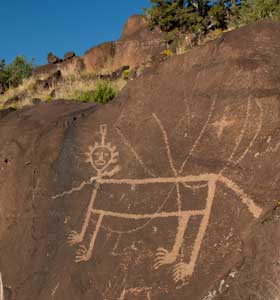
A five-foot mountain lion.
About a month after that public tour, I returned to Mesa Prieta to visit with Wells and Janet MacKenzie, Mesa Prieta’s archaeologist and project director. Wells directed me to a couple more of her hundred favorite petroglyphs, including a unique image that took her breath away in her early discovery days. I rounded the corner and immediately understood. It felt like the powerful, five-foot-long mountain lion was staring at us. He had a sunlike head, a boxy body, and five distinct toes on each of his four feet. A snake sliced through his neck.
As we continued, MacKenzie talked about how rich the mesa is with evidence of human use. When she became the nonprofit’s first staff archaeologist in 2010, she expanded Mesa Prieta’s recording protocol beyond petroglyphs to include every item used by humans. Volunteers have recorded horseshoes, cow horns, animal bones, a Coke bottle that hasn’t been made since 1924, and a finger-length eight-row corncob that dates to some time before 1846.
Twelve volunteer recording teams have surveyed 7,000 acres so far, hiking up rocky, cactus-infested terrain to collect comprehensive data and photos of each petroglyph, which are then processed and put into a secure database in three locations across the country, a first-of-its-kind system. Ultimately researchers will be able to use mapping software that allows them to click on a dot on a map and see pictures and information about the petroglyph there.
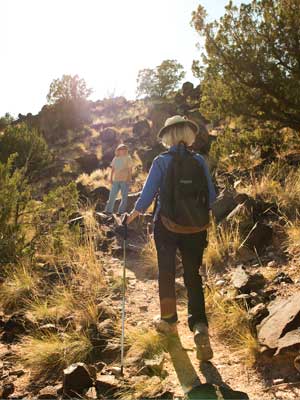 Janet MacKenzie, an archaeologist and project director of the Mesa Prieta Petroglyph Project, waits for Wells as they hike along the
Janet MacKenzie, an archaeologist and project director of the Mesa Prieta Petroglyph Project, waits for Wells as they hike along the
12-mile-long basalt formation.
“We are creating the building blocks of an important piece of New Mexico history that is going to be a signal achievement when it’s done,” MacKenzie says.
Mesa Prieta has collected awards for its education work from the Santa Fe Community Foundation and the American Rock Art Research Association, which also honored Wells with its Conservation and Preservation Award. Wells still expresses amazement at how the years have unfolded, how she became the matriarch of a project that lets us peek into our past, absorbing and contemplating the cultures and beliefs of our ancestors.
“In a way I did make it happen, but how could I not?” she questions. “I was fortunate to have the kind of resources to start something. I had enough of an education to know it’s important, enough of an imagination to see what’s possible, and I felt enough of a connection and a responsibility that I couldn’t live here and not be a steward and share it. I had to do what was needed. I knew that was part of the deal.”
Most important to Wells, the Mesa Prieta Petroglyph Project is creating an incredible tool for scholars by contributing to New Mexico’s vast petroglyph record, which the state archivist says is one of the best in the country. There are more than 4,000 archaeological sites here with documented petroglyphs, and only 11 percent of the state has been surveyed so far.
No one knows how many more carvings are out there waiting to be discovered, waiting for a Katherine Wells to understand the significance of a site and open up its treasure chest for the rest of us. As Wells says, “Everyone’s history is on the rocks.”
—Deborah Busemeyer is featured in “Storytellers”
GO SEE: Mesa Prieta
The Mesa Prieta Petroglyph Project hosts public tours on a portion of the mesa called the Wells Petroglyph Preserve, about an hour north of Santa Fe. Each of the six marked dirt paths are 1⁄4 to 1⁄2 mile, winding past large boulders where you can see the densest collection of petroglyphs in New Mexico from three distinct historical periods.
Public tours in 2016 will be held on May 14, May 22, September 3, September 11, and October 15. Cost is $25 per person.
Most tours start at 9:30 a.m. and take about two hours. You will receive detailed driving instructions with a map once you register and pay for a tour. Due to potential erosion issues, Mesa Prieta is accessible only via docent-led tours.
- No pets or children younger than 10 are allowed.
- Visitors must be able to walk over rocky terrain.
- Sturdy shoes and long pants are recommended to avoid cactus pricks.
- The sun can be intense: Bring lots of water, sunscreen, and a hat.
For the most up-to-date information about Mesa Prieta tours and Mesa Prieta Petroglyph Project, visit mesaprietapetroglyphs.org; (505) 852-1351.


